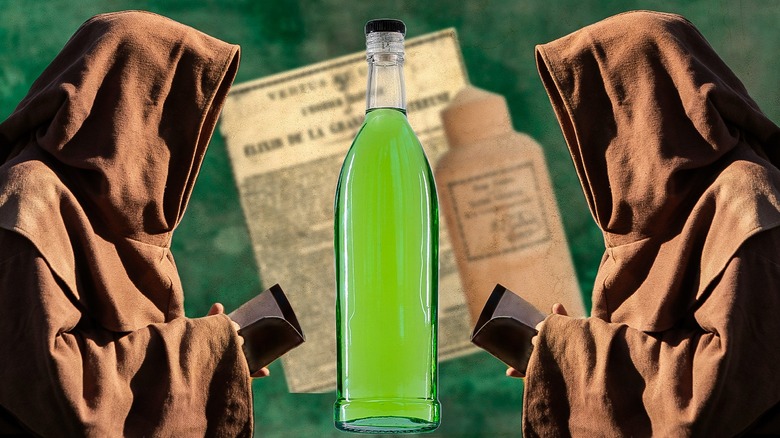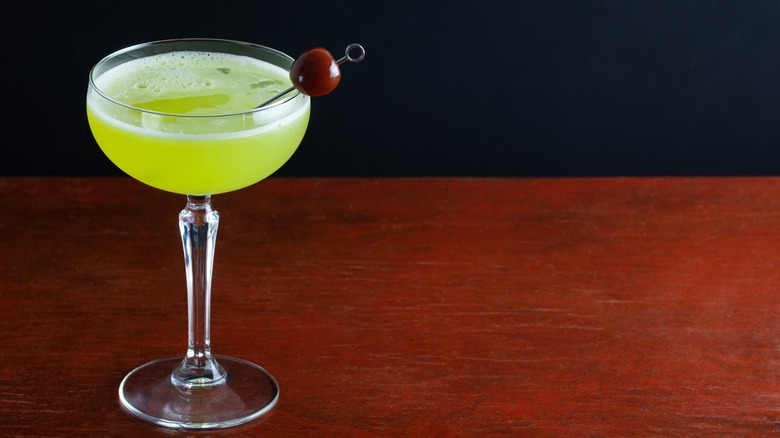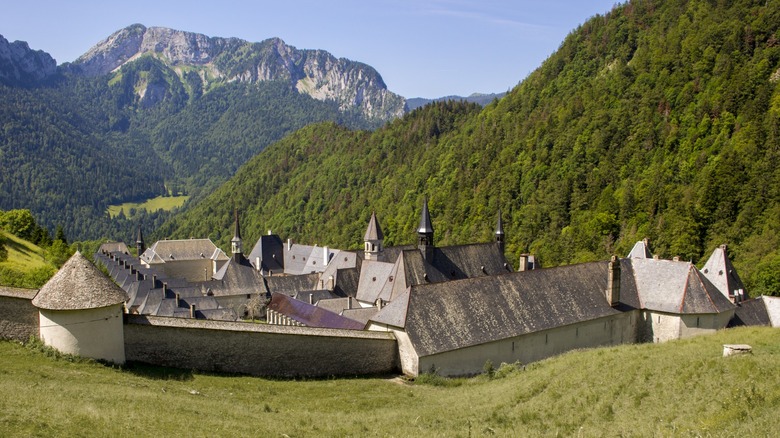Only 2 Monks Know How To Make This Centuries-Old Liqueur
We may receive a commission on purchases made from links.
There's something about European monastic orders and alcohol production that seems to go hand-in-hand. Of course, many orders of monks are renowned for their beer brewing. But they've also got a reputation when it comes to crafting quality liqueurs, and you need look no further than the highly sought-after Chartreuse — a complex liqueur composed of 130 herbal ingredients. And though it's perhaps most known nowadays as a key component in several classic cocktails such as the Last Word (which itself has an intriguing backstory), it's historically situated as a unique liqueur with a mysterious secret recipe and what are at times believed to be medicinal properties.
The famed green Chartreuse packs quite a punch at 55% ABV, or alcohol by volume. That, combined with its herbal components, might indeed help with mild aches (though it's certainly not actual medicine). While this is certainly interesting on its own, perhaps the most fascinating piece of lore surrounding Chartreuse is its recipe — something that's held in secrecy to this day. In fact, the complex recipe for Chartreuse is so closely guarded that, even though a third party distiller handles day-to-day operations of the liqueur, most people involved in its production don't know how to make it. The New York Times reported in 2020 that only two Carthusian monks in France have access to the full recipe. These monks are the only people who can view the 17th-century manuscript that outlines the ingredients required for Chartreuse, and every generation, two new monks are selected to continue this tradition. For as widespread as Chartreuse has become, it remains a liqueur covered in both history and mystery.
The Carthusian monks take Chartreuse very seriously
Although the liqueur now known as green Chartreuse wasn't perfected until around 1840, its 130 botanicals are still drawn from the circa-1605 manuscript for an elixir of long life, or "eau de vie." And this manuscript has proven crucial to the production of Chartreuse, since it's still used as a reference in Chartreuse's fabrication. It is in the guarding of this manuscript that the Carthusian monks of northern France can keep their recipe a secret. No one but the order's two designated monks can view it, and only one monk holds the key to the safe it's held in. According to the 2005 documentary "Into Great Silence", the panoply of ingredients are already sorted by the brotherhood before being sent to their partner distiller, maintaining complete secrecy. But what if anything were to happen to these two secret-holders before passing down their knowledge?
Fortunately for all who enjoy Chartreuse, a Carthusian's knowledge of the liqueur is not binary — it's not as if they either have complete knowledge of the liqueur or none at all. Many monks take part in the preparation and distilling process without knowing the full recipe. And while the general public isn't privy to any contingencies should anything tragic befall one or both of the designated monks, it's safe to assume that there are other monks among the order who are quite seasoned in the ins and outs of Chartreuse who can take the reigns in case of emergency.
The recipe for Chartreuse has had a tumultuous history
Chartreuse has a mysterious origin, but its history since then is also intriguing. Tracking down the past of Chartreuse and its recipe-holders is a difficult task — partly because the Carthusian monastery forbids media inside its walls and also because these monks have vowed silence around the Chartreuse production process. As well, tracing one manuscript all the way from its 1605 origin to the present day is tough when you remember the governmental and societal changes in France over the past four centuries. But luckily, the official website for the Chartreuse distillery does well in outlining the storied past of the liqueur, including the times when the order was uprooted and when the all-important manuscript was almost lost.
The Carthusians originally operated in the French kingdom. So when the French Revolution happened in 1789 and overthrew the monarchy, the order was put under heavy scrutiny by the new regime. This culminated in 1792 when they were expelled from their monastery. And crucially, the 1605 manuscript got out of the hands of the monks. Thankfully, a pharmacist named Pierre Liotard, who had ties with the Carthusians, recovered the manuscript in 1800. Eventually the monks were allowed to return to their monastery, and the Carthusians managed to purchase the manuscript from Liotard's widow in 1835. From there, they were affected by everything from landslides to an epidemic to the devastation of the World Wars. So next time you enjoy the one-of-a-kind substance, know that you're tasting something that has survived centuries of turmoil to be enjoyed by amateurs and enthusiasts alike.


